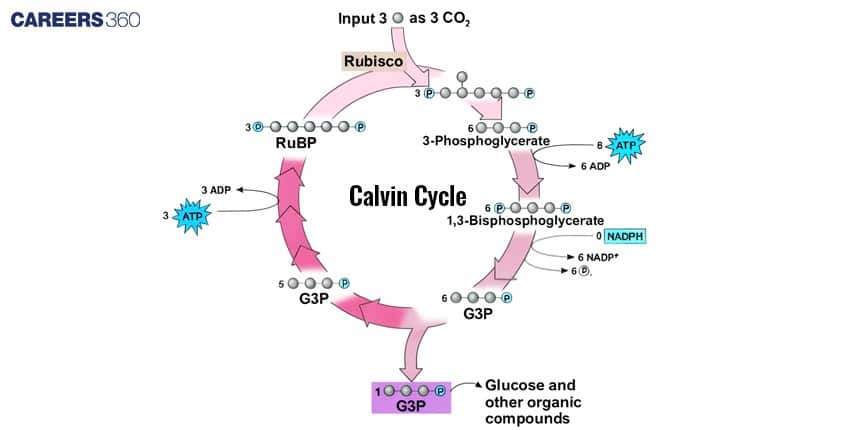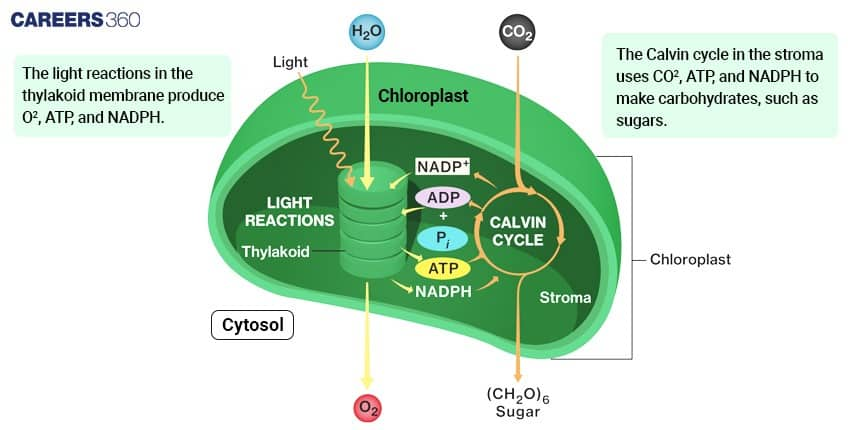Calvin Cycle Dark Reaction
The Calvin Cycle, also known as the C₃ Cycle or light-independent reaction, converts carbon dioxide (CO₂) into glucose using ATP and NADPH produced in light reactions. It occurs in the stroma of chloroplasts and forms the foundation of carbon fixation in C₃ plants. This process, discovered by Melvin Calvin, is essential for photosynthesis and ecosystem energy flow.
This Story also Contains
- What Is The Calvin Cycle?
- Stages Of The Calvin Cycle
- Products Of The Calvin Cycle
- Importance Of Calvin Cycle
- Difference Between Light and Dark Reactions
- Calvin Cycle NEET MCQs (With Answers & Explanations)

What Is The Calvin Cycle?
The Calvin cycle, otherwise known as the C3 cycle, is a process that takes place in green plants and autotrophs. It produces organic molecules from carbon dioxide. These organic molecules are rich in C–H bonds and highly reduced compared to CO₂.
Photosynthesis is divided into two major steps: the light-dependent reactions that require light and happen in daylight, and the light-independent reactions (also known as the dark reactions or the Calvin Cycle, C3 Cycle), which occurs regardless of whether light is present or not, this cycle works more actively during a day when there is plenty of supply of NADPH and ATP.
Carbon is derived from CO₂, while ATP and NADPH, produced during photosynthesis, provide the energy to fix carbon. The stages and activities of the Calvin Cycle are, thus, a precondition for a full understanding of how plants make their food and, in turn, help the ecosystem to exist.

Stages Of The Calvin Cycle
The Calvin Cycle can be categorized into three major steps:
Carbon fixation
The reduction of CO₂ is the most crucial step of the Calvin Cycle. The CO₂ binds to RuBP in a step called carbon fixation to yield two three-carbon molecules of 3-phosphoglycerate, 3-PGA. The reactant for this is catalyzed by the enzyme ribulose bisphosphate carboxylase/oxygenase or RuBisCO. This is a large enzyme with four subunits and is found in the stroma. RuBisCO is said to be the most abundant protein on Earth and yet it only processes about three molecules of RuBP per second.
Reduction Phase
In the second step of the Calvin Cycle, 3-PGA formed during carbon fixation is reduced to form glyceraldehyde-3-phosphate (G3P), a simple sugar. That step is energized by the ATP and NADPH from the light-dependent reactions. So the general role of the Calvin Cycle is to offer an avenue for the conversion of sunlight energy into long-term energy storage molecules, in this case, sugars. The reason that this step is called reduction is that electrons are donated to the 3-PGA forming G3P.
Regeneration Of RuBP
The third phase of the light-independent reaction is the regeneration of RuBP from G3P. This step is essential so that the cycle can be repeated as RuBP is used up in the first step of carbon fixation. Several molecules of G3P are used to synthesise glucose and some are re-circulated back to regenerate RuBP. This regeneration consumes some ATP also. RuBP is regenerated so that RuBisCo can continue to fix carbon dioxide in the cycle
Summary of the Stages
Step | Input | Product | Enzyme |
Carbon fixation | CO2, RuBP | 3-PGA | RuBisCO |
Reduction | 3-PGA, ATP, NADPH | G3P | G3P Dehydrogenase |
Regeneration | G3P, ATP | RuBP | Multiple enzymes |

Products Of The Calvin Cycle
The products of the Calvin cycle are:
At each turn of the Calvin cycle, one molecule of carbon is fixed.
Three cycles produce a net gain of one molecule of glyceraldehyde-3-phosphate G3P.
One glucose molecule is produced from two molecules of G3P.
In the reduction of 3-PGA to G3P and the regeneration of RuBP, 3 ATP are consumed net along with 2 NADPH.
In the formation of one glucose molecule, a total of 18 ATP along with 12 NADPH are consumed.
Importance Of Calvin Cycle
The importance of Calvin cycle is:
It is a central process for carbon fixation in the plants.
It provides glucose for the processes like respiration and biosynthesis.
It maintains the balance of carbon dioxide in the atmosphere.
It forms the basis for C3 plant metabolic reactions.
Difference Between Light and Dark Reactions
The difference between the light and dark reactions is:
Feature | Light Reaction | Dark Reaction |
Site | Thylakoid membrane | Stroma |
Requirement | Light energy | ATP, NADPH |
Product | ATP, NADPH, O2 | Glucose, ADP, NADP+ |
Type | Photochemical | Biochemical |
Involvement of CO2 | No | Yes |
Calvin Cycle NEET MCQs (With Answers & Explanations)
Important topics for NEET are:
Stages of Calvin cycle
Products formed in Calvin cycle
Practice Questions for NEET
Q1. Dark reaction takes place in the
Thylakoids
Lumen of thylakoids
Stroms
Intermembrane space
Correct answer: 3) Stroma
Explanation:
The dark reactions are also termed the Calvin cycle, taking place within the stroma of the chloroplasts. In the dark reactions, carbon dioxide is fixed into organic molecules utilizing the ATP and NADPH, which are formed in the light reaction. The entire cycle has a series of enzymatic reactions that assimilate carbon dioxide to glucose to provide the plant energy and building blocks for the plant's growth and metabolism.
Hence, the correct answer is Option 3)Stroma.
Q2. How many molecules of ATP and NADPH are required for every molecule of CO2 fixed in the Calvin cycle?
2 molecules of ATP and 3 molecules of NADPH
2 molecules of ATP and 2 molecules of NADPH
3 molecules of ATP and 3 molecules of NADPH
3 molecules of ATP and 2 molecules of NADPH
Correct answer: 4) 3 molecules of ATP and 2 molecules of NADPH
Explanation:
Three ATP molecules and two NADPH molecules must be added to the Calvin cycle to fix one CO₂ molecule. The different stages of the cycle depend on these chemicals. In the reduction phase, 3-phosphoglycerate is changed into 1,3-bisphosphoglycerate, and in the regeneration phase, ribulose-1,5-bisphosphate (RuBP) is produced using ATP.
Hence, the correct answer is option 4) 3 molecules of ATP and 2 molecules of NADPH.
Q3. The correct sequence of steps of dark reaction are
Regeneration - carboxylation - reduction
Reduction - oxidation - hydrogenation
Carboxylation - reduction - regeneration
Reduction - carboxylation - regeneration
Correct answer: 3) Carboxylation - reduction - regeneration
Explanation:
The Calvin cycle is an important series of reactions in photosynthesis, which is divided into three major stages:
Carboxylation: In the first step of this process, carbon dioxide, CO₂ is fixed into an organic molecule. Here, the action of the RuBisCO enzyme catalyses the reaction of CO₂ with the ribulose bisphosphate, RuBP, to give 3-PGA.
Reduction: This is the step where ATP and NADPH, produced during the light-dependent reactions, reduce 3-PGA to form glyceraldehyde-3-phosphate (G3P). It is the reduction of 3-PGA in which energy-rich molecules are produced.
Regeneration: In the final step, some G3P molecules are used to regenerate RuBP, enabling the cycle to continue. This regeneration requires ATP and ensures that the cycle can repeatedly fix CO₂.
These together enable plants to convert atmospheric CO₂ into organic compounds that can be used in growth and energy storage.
Hence, the correct answer is option 3) Carboxylation - reduction - regeneration.
Also Read:
Frequently Asked Questions (FAQs)
The Calvin Cycle refers to the process of biochemical reactions in photosynthesis by which carbon dioxide is converted into glucose.
The major steps are Carbon Fixation, Reduction, and Regeneration.
It takes place in the stroma of chloroplasts of plant cells.
It is the vital cycle to transfer CO2 into organic forms required for plant growth and the supply of food to heterotrophic organisms.
Such factors include light intensity, temperature, and carbon dioxide concentration.